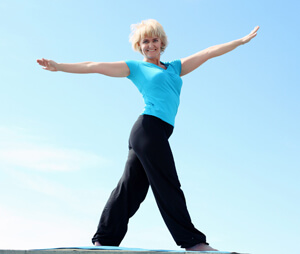Five exercises to improve balance and lower the risk of falling
Falls are a leading cause of injuries in older adults. Each year, it’s estimated that 1 in 3 older adults (65 years or older) will suffer a fall. Once somebody experiences a fall — his or her chances of falling again doubles.
Preventing falls requires work on a number of fronts. A good start is to make your loved one’s home safer and having his or her vision and medications regularly checked by a health care provider. But one of the most important things you can do is to encourage daily activity and improving balance. Falls often occur due to weakness of the legs and lower body. Keeping one’s muscles strong can help keep someone from having a fall in the first place.
For adults, this work starts well before they turn 65. The Center for Disease Control recommends that all adults do 150 minutes of moderate-intensity aerobic activity (brisk walking, swimming, bike riding, playing golf or pushing a lawn mower) each week. Along with that, they should also do muscle-strengthening activities (exercises using weight machines, climbing stairs, gardening, yoga or Tai Chi exercises).
For older adults, it’s recommended that they stay as physically active as your conditions allow. Some of the exercises that they can do to maintain or improve one’s balance include:
- Backwards walking for 10 steps.
- Walking sideways for 10 steps.
- Heel to toe walking on a straight line for 10 steps.
- Walking on the front of one’s toes for 10 steps.
- Sitting in a chair and coming to a full stand.
Encourage your loved one to try each of these for a total of five minutes, three times a week. For each of these, you can make them easier or tougher depending on his or her ability level. To make it easier, hold onto furniture or a counter while doing them. To make it harder, stand on a pillow or a soft surface.
If the exercises listed above are easy, as a bonus challenge try standing on one leg for 30 seconds, without legs touching and with the arms crossed at the chest. This challenge also can be adjusted for difficulty the same way as noted for the five exercises above.
For many older adults, staying fit and in shape is more about improving their health and reducing risk of injury. It’s about independence and being able to enjoy their lives. For someone who has lived a long life, what could be more important?
More online: View more examples of lower-body exercises from the National Institute on Aging.
